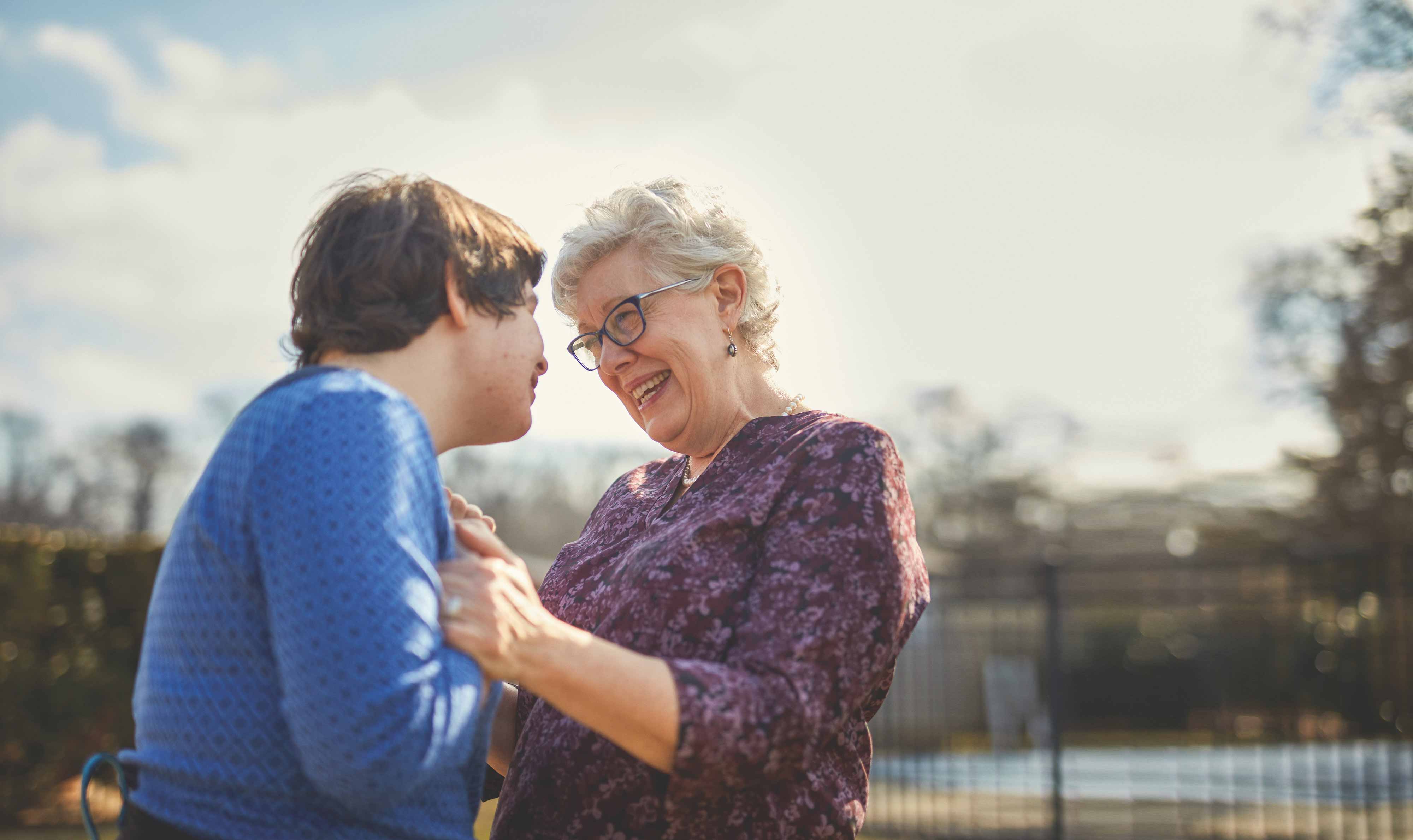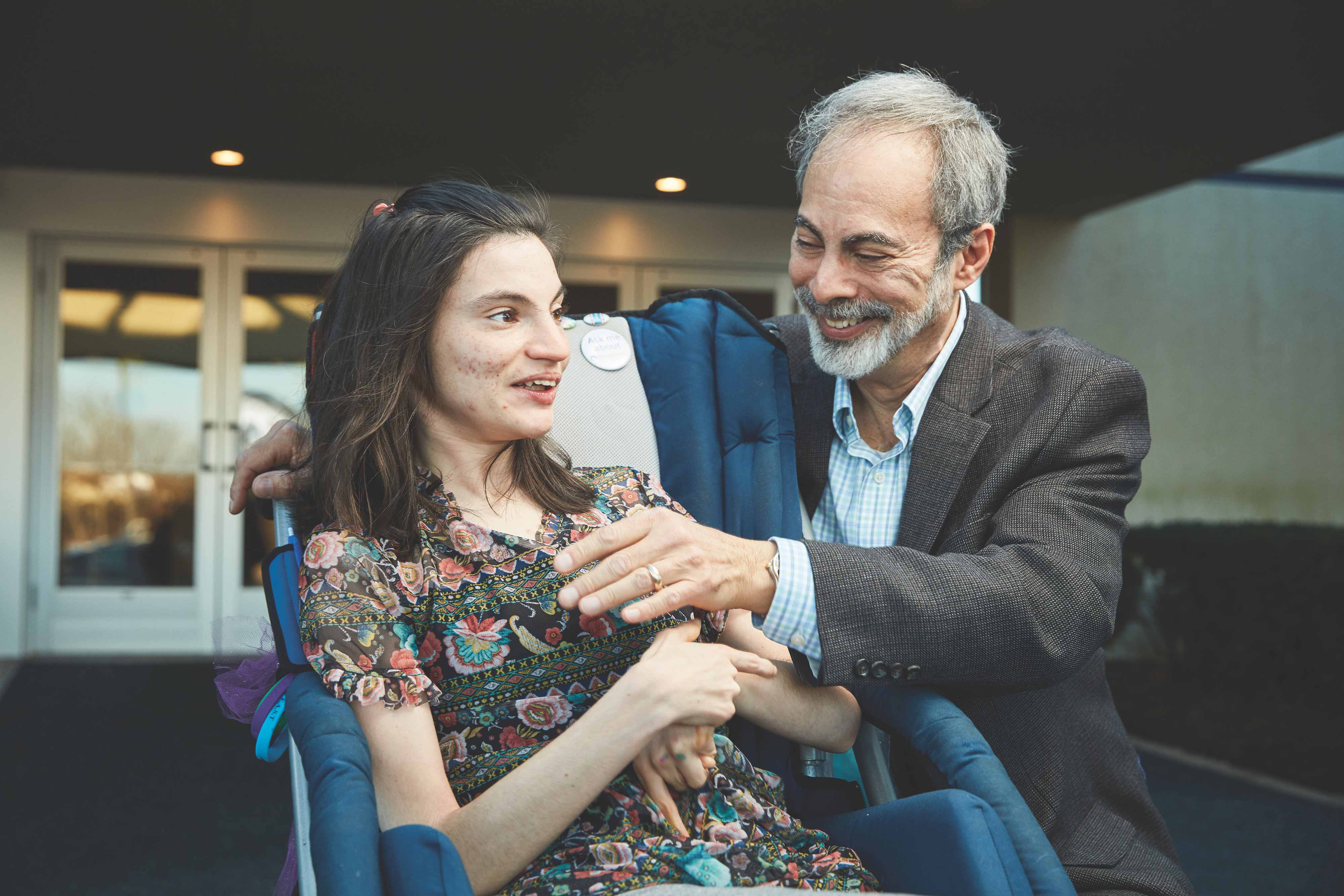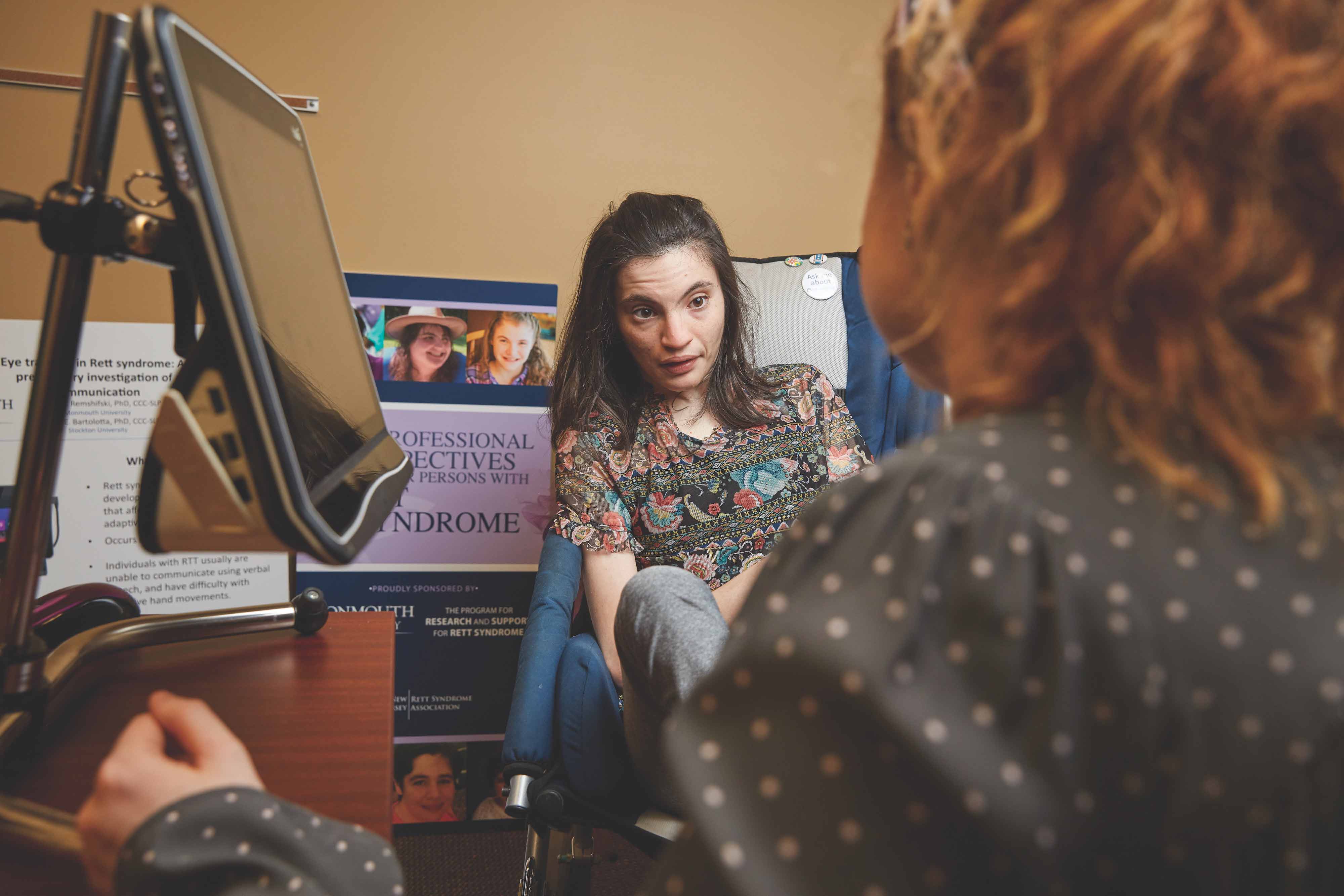
Language of Love
A rare neurological disorder robs girls and women of simple communication. A new effort aims to help give them their voices back.
For the first year after the birth of Theresa Bartolotta’s daughter, Lisa, everything went along seemingly well.
The infant was quick to smile, and though she took a bit longer than Bartolotta’s son had to sit independently, she eventually got it. Lisa started pulling to stand up at around 10 months, well within the normal time frame. Shortly after, she started “cruising,” holding onto the wall for support as she made her way into her older brother’s room to knock books off his shelf.
Every milestone was happily recorded by Bartolotta in a new baby book.
Then one day, at around 14 months, Bartolotta noticed something peculiar. Lisa kept saying one particular word, “bleeka,” over and over. Curious, Bartolotta recorded the phrase in her book. It ended up being the last entry she made.
“Kids usually go ‘ba ba ba ba’ and ‘ba, da, da, da,’ and Lisa would go ‘bleeka, bleeka, bleeka’ all day,” says Bartolotta, a professor in the Department of Speech and Language Pathology. “And it took me a long time, probably a month, to talk to someone to say something’s not right.”
Lisa’s path along normal development hit a road block, and after months of doctors’ visits, she was diagnosed at 18 months as being “developmentally delayed” and exhibiting “some features of autism.” Bartolotta was told to get Lisa into early intervention as soon as possible, and while she did, Lisa’s condition didn’t much improve.
It wasn’t until a decade later, in 1999, when the gene mutation for Rett syndrome and its associating symptoms was identified, that Bartolotta felt she may have found an answer for her daughter’s wide-ranging symptoms. Despite the fact that neurologists brushed the idea of a Rett diagnosis aside—one simply said, “Oh, no, you don’t want her to have that”—Bartolotta and her husband drove Lisa to Johns Hopkins University School of Medicine in Baltimore, Maryland, one of only two hospitals in the country testing for the disorder at the time. After nine months of waiting, in early 2000, she got the results: Lisa did have Rett syndrome. She was 11 years old at the time.

An Insidious Disease
Rett syndrome is a rare, largely non-inherited, genetic neurological disorder that occurs almost exclusively in females. The mutation of the MECP2 gene on the X chromosome, which occurs spontaneously during early development prior to birth, affects one in every 10,000 to 15,000 girls born worldwide, with no regard to racial, ethnic, or socioeconomic background.
The MECP2 gene encodes the protein by the same name that is found in all neurologically derived cells in the human body. It is essential for the normal function of neurological development, but too much or too little of the protein leads to severe abnormalities of cell function—too little of the protein leads to Rett syndrome in girls, while too much of the protein leads to MECP2 duplication syndrome, which contrary to Rett, occurs almost exclusively in males. (See sidebar, below.)
Typically, girls born with Rett develop normally up to the first 18 months of age, at which time their development slowly begins to regress, causing them to lose previously acquired skills. Those living with Rett are affected by myriad symptoms, which exist on a spectrum similar to autism, and typically includes delayed growth, microcephaly, impaired communication, and unusual eye and hand movements as well as loss of functional use of the hands. They are prone to irregular breathing habits, such as holding their breath; they often have cardiac, circulatory, and digestive impairments; and over 80 percent have seizures, which can be severe enough to cause death.
The disease is often described as having symptoms of autism, cerebral palsy, Parkinson’s, epilepsy, and an anxiety disorder all wrapped into one.
The Communication Barrier
Perhaps the most challenging and frustrating symptom is the regression of the child’s ability to communicate—words learned slip away and are often lost forever. Unable to functionally use their hands, girls with Rett cannot write or sign, leaving the child with limited ability to communicate their wants, needs, and discomforts, of which there are many.
“It’s kind of like the shoemaker’s kids have no shoes,” Bartolotta says of experiencing this challenge with her own daughter when she herself has more than 30 years of clinical experience as a speech-language pathologist. “I was working with all of these young children who had communication problems, and my daughter was developing her own communication problems, and I really couldn’t figure them out.”
While advancements have been made in genetic testing to find a cure, or a way to ease or improve symptoms, communicating with children who have Rett today continues to be a major challenge.
The only way many girls can learn to effectively communicate is through the use of their eyes, as they maintain control over their ocular muscles. Parents are often able to pick up on the subtle nuances in body language and eye expression—knowing when their children are hungry, or uncomfortable, or if they want to listen to music or watch their favorite shows.
The problem is that professionals, including caretakers, teachers, and therapists, are less attuned to these subtleties and may misread or altogether miss the message the child is trying to send.
Luckily, there are ways for the girls to learn to use eye-tracking technology to express themselves. There are low-tech, non-electronic tools that can be used, such as paddles that can be raised for simple answers, like yes or no; and there are language boards that can be outfitted with pictures and held up while one tracks the patient’s eye movements to see what she is focusing on.
There are also sophisticated electronic eye-tracking devices, where a sensor follows one’s eye movements and syncs with computer software to track points of focus. This allows for more complex communication and also allows the girls to utilize apps, via the device, through which they can learn, play games, or even turn synced light switches on and off.
But even with this technology, many hurdles still exist for individuals with Rett and their families. For one, not all teachers, therapists, and speech-language pathologists (SLPs) know what Rett syndrome is, let alone how to communicate effectively with girls with Rett. In the same vein, many SLPs and specialists have not communicated with a patient who utilizes an eye-gaze device. On top of that, the equipment can be expensive—some systems cost tens of thousands of dollars—and is sometimes difficult for parents to get approved through insurance.
Even then, once equipment is purchased, parents need access to specialists who can teach them and their daughter how to effectively program and communicate using the device. Each device needs to be programmed in a specific way to meet the needs and abilities of each individual girl. There is no one-size-fits-all approach to assessing the patient’s ability to communicate or to knowing what the best communication strategy is, let alone knowing the best way to program the device for that particular patient.
“The device is important, but the SLP and the augmentative communications specialist … are two huge and important keys,” says Gerard Saydah, whose daughter, Michelle, has Rett. “She has the device, and … as much as we [mom and dad] want to help her with it, we’re not trained in that. So we can help, but only to a point.”
A Lifelong Mission
Bartolotta says effective approaches toward communicating with Rett girls are lacking not only because it’s a niche disorder, but also because only recently did doctors realize these girls have a larger capacity to learn and communicate than was originally thought.
“If you look at the literature … you find very little positive information to help you to develop a communication intervention for girls with Rett syndrome,” she says. “It’s a rare disorder, so it’s rare that a teacher or a therapist who encounters your child will know that they have Rett syndrome. And if they read the early articles, the early articles are very discouraging. They talk about severe disability, lack of progress, only regression—we now know that is not true.”
With those challenges in mind, Bartolotta set out to broaden the communications horizon for girls with Rett. Her 2005 dissertation focused on the perception that parents, teachers, and SLPs have of girls with Rett in regards to their communication abilities.
Several years later, she teamed up with a former classmate from her doctoral program, Patricia Remshifski, who is the current chair of Monmouth’s Speech-Language Pathology Department. The two co-published a paper in 2012 that examined communication intervention with Rett patients during mealtime. In 2013, they received a $60,000 grant from Rettsyndrome.org to study eye tracking in girls with Rett syndrome, specifically regarding receptive and expressive vocabulary.
That same year, Remshifski joined Monmouth’s School of Education to run the SLP program. From the moment she arrived, she advocated for making Monmouth’s Center for Speech and Language Disorders a resource for Rett patients and their families and a center for research related to the syndrome. In early 2017, with support from John Henning, dean of the School of Education, she got the approval to start a Rett program at Monmouth.
Remshifski had long been developing the idea for such a program with Bartolotta, who at the time was dean of the School of Health Sciences at Stockton University. The two reached out to the New Jersey Rett Syndrome Association (NJRSA) and Rettsyndrome.org to partner and help them to develop their mission. They recruited a board, and several months later, in August 2017, Bartolotta joined Monmouth’s faculty. Last November, Monmouth officially launched The Program for Research and Support for Rett Syndrome at a one-day inter-professional symposium on care for persons with Rett.

The Program
The mission of The Program for Research and Support for Rett Syndrome is threefold. It serves as an information hub where parents and family members of those living with Rett, along with professionals working with the Rett population, can get answers to questions as well as help with the challenges specific to the syndrome. It seeks to create educational and treatment programs specific to individuals with Rett syndrome that support patients and their families directly, while equipping students in Monmouth’s SLP program with the knowledge and experience of working with Rett patients. Along with this, it seeks to develop and implement community-based research and service learning initiatives focused on the syndrome.
The program is housed within Monmouth’s Center for Speech and Language Disorders, which offers evaluation as well as one-on-one and group therapy for a wide array of conditions beyond Rett, including articulation disorders, auditory processing disorders, autism, aphasia, and cognitive communication disorders. For a small fee, patients can attend biweekly treatment sessions that are run by graduate students in the SLP program and overseen by speech-language pathologists and faculty members who are certified, licensed SLPs. For most of the grad students, it is their first time working hands-on with patients, and for those working with one of the four Rett patients who utilize the clinic, it’s their first time working with someone who uses an eye-gaze device. Despite the challenges, it’s been a rewarding experience for the students.
“Not only was I learning how to be a professional in the field, but I was learning how to interact with that population in a therapeutic sense,” says Carleen Higgins of her time working one-on-one with Michelle last year. “That really helped me to grow as a clinician.”
The clinics are an especially important resource for students with Rett who have aged out of school, such as 23-year-old Michelle Saydah. She only began using an eye-gaze device a few years ago, and as is the case with many persons with Rett, she has worked with various teachers, therapists, and augmentative communication specialists who have organized her eye-gaze software in various ways. This semester, the Monmouth team is trying to organize Michelle’s device to create a consistent user interface for all of her pages.
“Basically it would be like if every time you turned on your television or turned on your computer, you had a different way to go back—sometimes it’s an arrow; sometimes it’s a right click,” says Michelle’s father, Gerard, of his daughter’s eye-gaze software. “They’re looking at Michelle holistically, and they’re like ‘What can we do to make this make more sense?’ And if they get to that, it will be very significant not only for Michelle, but they can probably leverage that for others.”
A Future Full of Hope
In addition to the clinics being a way for Monmouth’s students and faculty to study, treat, and assess the communication hurdles that girls with Rett face, there are also plans to carry out service learning projects throughout the community.
One such project, initiated by graduate student Madison Chase, is already underway and focuses on establishing a peer mentor program. Graduate students have been paired up with a person with Rett syndrome or another severe communication disability in a nearby school to serve as communication partners—the two communicate and talk in a non-therapy, social way.
“We’re trying to establish peer communication groups between people—your typical developing population and then your population that has a developmental disability, someone who is nonverbal,” says Chase. “It’s just bringing the two worlds together, which are sometimes just completely separated.”
The project is currently being initiated at two New Jersey schools: the Schroth School in Ocean Township and Hawkswood School in Eatontown.
Additionally, there are plans to run an annual inter-professional conference, which will bring together doctors, therapists, Rett experts, and parents to talk about recent developments in research and evidence-based communication strategies.
Bartolotta herself is currently working on an international project led by a team from the Rett Expertise Centre in the Netherlands to develop guidelines for the management of communication in Rett syndrome. The guidelines will not only help to broaden the awareness of the communications abilities of girls with Rett for parents and professionals, but will also help connect parents with tools, resources, and assessments to help them evaluate the best way to approach communicating with their daughters.
“People need a guideline—they need a road map to say, ‘OK, you have a girl with Rett syndrome; these are the kinds of things you can do when you approach and assess her communication and when you try to develop her communication,’” she says. “Because we don’t currently have literature out there that can guide people in that way.”
Bartolotta, whose daughter, Lisa, utilizes the clinic, says Monmouth’s program might be one of the few programs in the country with a mission focused on treating Rett patients from a rehabilitation standpoint versus a purely medical one.
“We’re trying to do the allied health side, the speech therapy side, the everyday care,” she says. “Because there’s a lot of interest in the medical side of Rett syndrome, but not as much in the rehab side, the day-to-day of how do you get them to communicate, how do you keep them walking and the things that have the biggest impact on quality of life.”
Gerard Saydah, who sits on the board of NJRSA and The Program for Research and Support for Rett Syndrome, has high hopes for the program’s future.
“We have Patty [Remshifski], who is the heart and soul of it, and then Theresa—my God, having them both here in the same place at the same time—Monmouth is just in the best possible place,” he says. “As a parent, we have a stake in having this be as successful as possible, and at the minimum, it will be a model. … But it’s not just helping the Rett population. What they’re learning here helps a very wide population of people, and a lot of people really need this.”